Secondary reinforcer - Study guides, Class notes & Summaries
Looking for the best study guides, study notes and summaries about Secondary reinforcer? On this page you'll find 512 study documents about Secondary reinforcer.
Page 2 out of 512 results
Sort by

-
Ultimate CPDT-KA study guide Questions And Answers
- Exam (elaborations) • 39 pages • 2024
- Available in package deal
-
- $13.49
- + learn more
Ultimate CPDT-KA study guide Questions And Answers operant conditioning - ANS learning process through which the strength of a behavior is modified by reinforcement or punishment. classical conditioning - ANS a learning process that occurs when two stimuli are repeatedly paired; a response that is at first elicited by the second stimulus is eventually elicited by the first stimulus alone. positive reinforcement - ANS Increasing behaviors by presenting positive stimuli, such ...
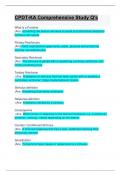
-
CPDT-KA Comprehensive Study Questions & Answers: Updated A+ Solutions
- Other • 11 pages • 2023
- Available in package deal
-
- $8.00
- + learn more
What is a Punisher (Ans- something the learner will work to avoid and diminishes likelihood behavior will repeat Primary Reinforcers (Ans- food, reproductive opportunity, water, physical and emotional security, sometimes play Secondary Reinforcer (Ans- The stimulus is paired with or predicting a primary reinforcer, EX: clicker predicting food Tertiary Reinforcer (Ans- A behavior or stimulus that has been paired with or predicts a secondary reinforcer; helps create behavior chain...
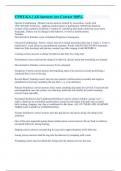
-
CPDT-KA || All Answers Are Correct 100%.
- Exam (elaborations) • 13 pages • 2024
-
Available in package deal
-
- $10.99
- + learn more
Operant Conditioning - Skinner correct answers learned by association -works with VOLUNTARY behaviors - applying reinforcement or punishment AFTER the behavior Creator of this method considered a "reinforcer" something that made a behavior occur more frequently. If there was no change in the behavior, it wasn't a reinforcement. Formula: Discriminative Stimulus (your command)-Response-Consequence Classical Conditioning - Pavlov correct answers Learned association between 2 events: 1 eve...
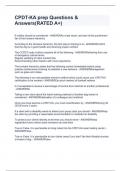
-
CPDT-KA prep Questions & Answers(RATED A+)
- Exam (elaborations) • 18 pages • 2024
-
Available in package deal
-
- $13.19
- + learn more
E-collars should be considered - ANSWERAs a last resort, and part of the punishment tier of the humane hierarchy According to the Humane hierarchy, the first step in training is to - ANSWERConfirm that the dog is in good health and receiving proper nutrition The CCPDT code of ethics requires all of the following - ANSWERRefraining from use of derogatory cultural terms Regular updating of client contact lists Recommending other trainers with more experience The humane hierarchy states ...
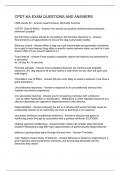
-
CPDT-KA EXAM QUESTIONS AND ANSWERS
- Exam (elaborations) • 11 pages • 2024
-
Available in package deal
-
- $12.49
- + learn more
LIMA stands for - Answer-Least Intrusive, Minimally Aversive CCPDT Code of Ethics - Answer-You should use positive reinforcement techniques whenever possible the first thing a trainer should do according to the Humane Hierarchy is - Answer-Recommend a vet appointment to ensure the dog is physically healthy Stimulus control - Answer-When a dog can both discriminate and generalize a behavior, he is said to have learned (dog offers a specific canine behavior when you ask for it and doesn'...
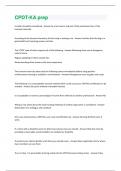
-
CPDT-KA prep Questions With 100% Correct Answers.
- Exam (elaborations) • 23 pages • 2024
- Available in package deal
-
- $8.39
- + learn more
E-collars should be considered - Answer-As a last resort, and part of the punishment tier of the humane hierarchy According to the Humane hierarchy, the first step in training is to - Answer-Confirm that the dog is in good health and receiving proper nutrition The CCPDT code of ethics requires all of the following - Answer-Refraining from use of derogatory cultural terms Regular updating of client contact lists Recommending other trainers with more experience The humane hierarchy states ...
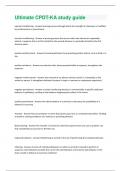
-
Ultimate CPDT-KA study guide Graded A+
- Exam (elaborations) • 53 pages • 2024
- Available in package deal
-
- $7.99
- + learn more
operant conditioning - Answer-learning process through which the strength of a behavior is modified by reinforcement or punishment. classical conditioning - Answer-a learning process that occurs when two stimuli are repeatedly paired; a response that is at first elicited by the second stimulus is eventually elicited by the first stimulus alone. positive reinforcement - Answer-Increasing behaviors by presenting positive stimuli, such as food or a toy. positive reinforcer - Answer-any stimu...
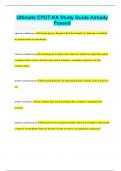
-
Ultimate CPDT-KA Study Guide Already Passed
- Exam (elaborations) • 93 pages • 2024
- Available in package deal
-
- $11.99
- + learn more
Ultimate CPDT-KA Study Guide Already Passed operant conditioning learning process through which the strength of a behavior is modified by reinforcement or punishment. classical conditioning a learning process that occurs when two stimuli are repeatedly paired; a response that is at first elicited by the second stimulus is eventually elicited by the first stimulus alone. positive reinforcement Increasing behaviors by presenting positive stimuli, such as food or a toy. positive ...
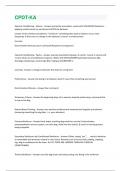
-
CPDT-KA exam (100% correct and graded A+)
- Exam (elaborations) • 17 pages • 2024
- Available in package deal
-
- $8.39
- + learn more
Operant Conditioning - Skinner - Answer-learned by association -works with VOLUNTARY behaviors - applying reinforcement or punishment AFTER the behavior Creator of this method considered a "reinforcer" something that made a behavior occur more frequently. If there was no change in the behavior, it wasn't a reinforcement. Formula: Discriminative Stimulus (your command)-Response-Consequence Classical Conditioning - Pavlov - Answer-Learned association between 2 events: 1 event is neutral a...
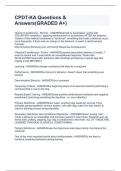
-
CPDT-KA Questions & Answers(GRADED A+)
- Exam (elaborations) • 14 pages • 2024
-
Available in package deal
-
- $12.79
- + learn more
Operant Conditioning - Skinner - ANSWERlearned by association -works with VOLUNTARY behaviors - applying reinforcement or punishment AFTER the behavior Creator of this method considered a "reinforcer" something that made a behavior occur more frequently. If there was no change in the behavior, it wasn't a reinforcement. Formula: Discriminative Stimulus (your command)-Response-Consequence Classical Conditioning - Pavlov - ANSWERLearned association between 2 events: 1 event is neutral an...

That summary you just bought made someone very happy. Also get paid weekly? Sell your study resources on Stuvia! Discover all about earning on Stuvia


